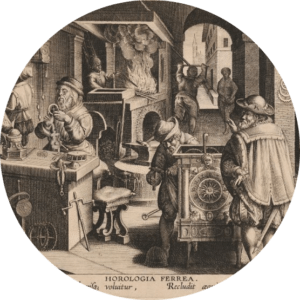These days, CNC (computer numerical control) machinery is increasingly being used, gradually ousting so-called conventional machines. In CNC machines, movement of the tool (which may be a laser, an electrical discharge machining (EDM) electrode, a water jet or more common cutting tools such as mills and drill bits) is controlled by computer, and human intervention is limited to providing the machine with the appropriate material and tools.
Although such machines enable industry (watchmaking included) to produce more items, of better quality, and offer amateurs the opportunity to try their hand at building mechanisms of their own invention, they are also, in my view, plainly a serious threat to manual craftsmanship.
Traditional watchmaking consists in building and assembling parts by sawing, filing, drilling, chamfering, forging, riveting, turning, cutting, stamping, hardening, hammering, and so on, with the material resounding to the blows of a tool guided at all times by a sensitive hand capable of feeling its effects on the material.
Two major consequences result from this turnaround in production means. The first is the loss of crafting skills handed down over countless generations, the second the devitalization of modern creations.
While the loss of horological expertise is regrettable in light of the centuries spent finding and refining it and ensuring its transmission, devitalization is far more serious. By devitalization, I refer to the cold, dispassionate side of computer-controlled productions that leave no room for the imperfections and harmonisations of hand-made pieces. The quest for perfection in modern “manufactures”, where watches are examined only under a magnifying glass (enlarging up to forty times) to seek out potential flaws, outweighs what appears to be the quality for which artisanal watch-designers formerly strove and still strive: harmony. Without praising flaws as such, I personally regard imperfection as the watchsmith’s personal hallmark imprinted in his creation by a wandering file, an over-enthusiastic hammer blow, a roving saw… as signs which, without altering it in any way, lend soul and character to the timepiece, testifying to its unique, hand-crafted nature.
This is the mindset that guides me in my creations. The focus is on manual work, and the term “Manibus Factum” (hand-made) assumes its original, literal meaning, where each component is built in stages and depends on the others, not just on the fabrication plan, and where I like to think that the time I spend making it leaves an intangible mark in the resulting timepiece as a whole. If Master Zacharius, Jules Vernes’ clockmaker, sees his clocks inexplicably stop in pace with his slowing heartbeat, it is because passion for his craft has put a little of him inside each one. A noble and inspiring philosophy, and one I modestly seek to follow.
“Modern man’s passion for machines is in no way the exaggeration of a natural feeling, but the mark of a terrible self-denial, an act of abdication. The man of machines will not be free of them until he is free of himself, because the artificial world they have enabled him to create matches his anxieties, and is no more than their projection onto things”
Georges Bernanos




